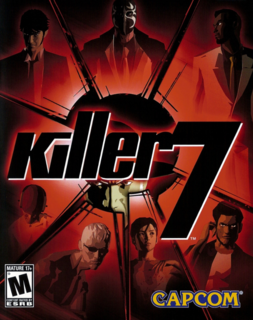Killer 7 is one of those rare games that blends artistry with astonishingly original game play and an intricate story.
The story of Killer 7 takes place in the near future in which global peace has been established among the nations of the world, leaving terrorist organizations to be the main antagonists. One group in particular utilizes deformed, chuckling suicide bombers called "Smiles" to instill fear across the world. The only group capable of stopping the Smiles is a small, seven-person team of assassins called the Killer 7, all bearing "Smith" as a last name. The progression of the story has a lot of enjoyable twists and turns, though the heavily political tone might wear on players who aren't fans of stories along the lines of Metal Gear Solid, which Killer 7 emulates not only in political messages but also headache-inducing intricacy. Nevertheless, the story of Killer 7 is definitely above-average and makes playing through levels enjoyable (though there are points in which the material gets incredibly disturbing, even for a game of it's kind), giving more than enough motivation to keep playing just to see what nutty extreme the story will go next.
The game play of Killer 7 is difficult to describe, though I will say that the end result is enjoyable. Movement takes place on set paths, meaning that exploring and entering new areas takes place on forks on the designated paths. With this styIe of movement, the controls are simplified by only having a single button to run along with a 180-degree turn to change direction on a straight path. Combat feels slightly similar to light gun games because of being required to stop dead in your tracks and aim in first-person view. The wide variety of enemies offers up a fresh, challenging experience with every level, most of the time introducing multiple new types per stage. Though each type of Smile has a specific method that needs to be applied in order to defeat them, all types have two things in common:
First, all Smiles have to be "scanned" in order to be seen, which means that a button has to be pressed while in shooting mode in order to expose the Smile. Thankfully, all smiles will chuckle when they are in the same area as the player, so being the victim of a sneak attack is rare. Each type of Smile has their own unique chuckle, which allows the player to anticipate what kind of enemy awaits them, making combat far less obtuse and more enjoyable.
Second, every Smile has a one-hit kill mark. However, the one-hit kill mark is randomized for most types of Smile so multiple scans (usually just two) may be needed to pinpoint where exactly it is. Even so, hitting the point awards the player with more "thick blood" (or experience points) to use toward upgrading the abilities of one of the seven characters. Thin blood is also collected from enemies, which can be used for either special attacks or healing.
Speaking of characters, the seven Smiths each have their own unique weapons such as a scoped handgun, throwing knives, a massive revolver, hand held grenade launchers, twin pistols, and so on. Every Smith makes themselves useful in environmental puzzles (which are more often than not character-specific) and when defeating particular types of Smile. One large plus to the multiple character system is being able to change at any time, eliminating a lot of potential backtracking and also easing up the consistently hard difficulty by giving each character their own personal health bar. However, when one character dies, the player will have to resort to using Garcian Smith, a man who takes the severed head of the deceased character and, through the power of wizardry (and button mashing), brings them back to life. Skilled players won't have much trouble getting through the game avoiding death (in most instances) but those new to shooting games might find the constant running back and forth to revive characters a little tiring. Thankfully, most points in which a character can die are close to a continue point, so the trek is fairly short.
Sound is an aspect in which Killer 7 excels, offering up a subtle soundtrack most of the time and blasting techno or alternative rock sparingly. The music is fairly enjoyable and, to be honest, I would like to pick up the soundtrack for this game if I found it. The voice acting, however, is a little spotty at times. The worst offense in voice acting comes from the one-liners the characters spout every time a one-hit kill occurs. Sure, they can be fairly entertaining for the first ten or so times but then every other time you'll feel like lines such as "this is too easy..." or "hurts, doesn't it?" will be stuck in your head for eternity. Still, it never gets old for the characters who swear in their one-liners and, if the players does get tired of the one-liners, they can switch over to the mute Kevin Smith.
In conclusion, Killer 7 is a game that any person who feels that video games can be creative should pick up. Chances are, you've never played a game like it, what with all the obtuse characters, intriguing choices in direction, and original game play elements. Indeed, patience is needed in order to fully enjoy the time you will spend with Killer 7 but anyone who has played through games like Resident Evil and Metroid in which backtracking is central will not find running through the stages too tiring. If you find a copy of this game in a bargain bin or a used media store, pick it up. It's well worth the investment.

